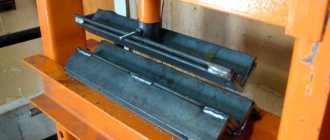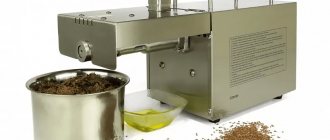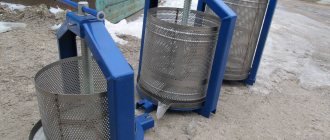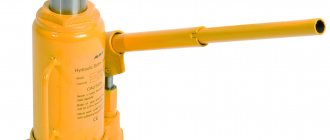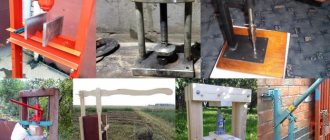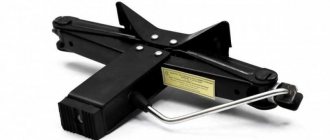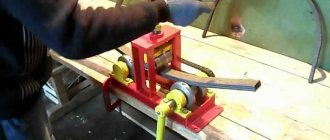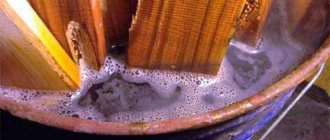Home craftsmen who make and repair various technical devices with their own hands often have to deal with pressing equipment. You can buy it on the modern market without any problems, but you can go the other way and make a functional and effective press with your own hands from a jack. By choosing this option for equipping your workshop with pressing equipment, you can manufacture a device at minimal cost that will fully meet the requirements for it, both in terms of technical and operational characteristics, and in size.
The press can be used for various purposes: for pressing bearings or bending metal. The design will be similar in any case, the only difference is the size and working attachments
Using a manual press made from a jack, which can fit in every workshop, you can successfully perform many technological operations at home, such as installing and dismantling bearings, pressing in and out of various bushings and shafts, and carrying out bending and simple stamping operations.
Features of the jack press
The equipment uses a hydraulic car jack for compression, which is rigidly mounted on the crossbars of the frame made of a steel profile. To operate the device, you need to swing the lever several times; the return stroke is carried out by springs after opening the valve.
The product can be carried indoors or transported to the work site in the trunk of a car.
Application and working principle
The quality and technical parameters of our own press are not inferior to factory-made models. Therefore, if you have a desire to save your family budget, start creating such a device yourself.
And if you look at the photos of the best ideas on how to make a press, you will come to the conclusion that the easiest way is to make one from a jack.
You can use a similar, home-made unit for such needs as:
- stamping and bending of various kinds of objects;
- forging metal parts;
- extrusion of steel profiles;
- packaging of wooden, plastic and metal products.
The operating principle of the jack press design is determined by hydrostatic laws. And it lies in the fact that pressure on one specific section of the workpiece helps to increase the efficiency in another
Home Applications
To squeeze metal elements out of the shell or base, you can buy or make a hydraulic press with your own hands for the garage. The equipment is also suitable for pressing out bearings and silent blocks that cannot be mounted and dismantled manually. Using such a device, you can straighten, join two elements, and bend a metal workpiece.
When making a press with your own hands, you need to decide on the further purpose of the device, its dimensions, piston performance, weight and the possibility of installing a pressure gauge.
When manufacturing a hydraulic press for a garage, it is necessary to take into account the dimensions of the vehicle being serviced.
When creating a hydraulic press for a garage, you should take into account the size of the car. For passenger vehicles, it is enough to make a simple design, but for large vehicles it is better to make a more complex and larger unit.
The device is often used as a waste paper press. With your own hands you can make good fuel for the stove from old paper. For such purposes, it is enough to make a simple design with an average power rating, which will allow you to recycle a large amount of waste paper.
The equipment is also suitable for pressing sawdust. Such briquettes are good fuel for stove heating; they burn for a long time without producing smoke, creating intense heat. Instead of sawdust, coal chips are also suitable as a filler for the press. Such a unit will consist of a work table, a base, a power frame and a drive.
A good result is ensured by a self-created press for PET bottles, which turns the container into neat layers. The hydraulic tool can be used as a hay picker. In this case, the design is complemented by a frame frame made of timber or metal without an upper part. The element is fixed to the front using special fasteners. You will also need a transport pick-up and running gear.
Hydraulic press is also used for squeezing juice from fruits.
Device
The structure consists of the following elements:
- a closed frame made of a profile, on which supports are provided to increase stability;
- a movable cross member on which the jack body is fixed;
- return springs located between the movable bar and the upper part of the frame.
Press device made from a jack.
Some craftsmen provide for the installation of screw supports, allowing the equipment to be mounted on an uneven floor. A vice or mandrel may be located on the lower cross member to hold the workpieces. The force is exerted by a steel plate or a punch made of a bolt or rod (the device allows you to squeeze a rolling bearing out of a gear or housing part).
Principle of operation
The workpiece must be placed on the lower cross member of the frame or mandrel. Then you should mount a tool with which the workpiece will be deformed. The press is manually driven by a lever that is inserted into a guide ring on the jack. After several movements of the handle up and down, the rod begins to lower the movable cross member.
After molding is completed, the valve should be unscrewed; the equipment will return to its original position due to the force of the stretched springs.
What is needed to make a press
The drawings of such a device allow you to make a press from a jack with your own hands. They are easy to find on the Internet in the public domain.
Drawing of a homemade press from a hydraulic jack
To make a hydraulic press from a jack, you should also prepare:
- the hydraulic jack itself is of a single-rod bottle type (for a press that will be used at home, a jack that develops a force of up to 10 tons is also suitable);
- inverter with a set of electrodes;
- hacksaw for metal;
- grinder with a set of discs designed for cutting metal;
- a section of channel size 8 and above, 4 m long;
- square or rectangular profile pipe with thick walls;
- equal-flange metal corner No. 50;
- steel strip having a thickness of more than 10 mm;
- a piece of pipe 10–15 mm long, the diameter of which should match the size of the jacking rod;
- metal plate measuring 25x10 cm and thickness 9–10 mm;
- two springs that are needed to return the stop to its original position (springs from car seats, doors, etc. are suitable).
Channel blanks
Necessary materials
To make a press, prepare:
- channel P-14;
- pipe 40*40 mm round or square section;
- corners;
- steel sheets (optimal thickness - 7 - 8 mm);
- centimeter thick metal plate;
- a piece of pipe measuring 10 - 15 cm.
Specifics of a hydraulic jack
It was not by chance that a hydraulic jack was chosen as the basis for the construction of a homemade press.
An important feature of this device is that its operation is based on the fundamental laws of physics, according to which a liquid under pressure does not compress or decrease in volume. This explains why there is no loss of power when the jack is applied to the workpiece.
In addition, the hydraulic jack has a fairly high efficiency (80%), which allows you to count on significant compression force in the case of a power press.
Advantages
Among the advantages of hydraulic presses, the main ones are:
- significant gain;
- the ability to implement different technological processes;
- high design reliability and safety;
- ease of work under a given mode;
- ease of control and low noise level;
- the ability to connect any hydraulic equipment to the drive (buckets, jackhammers, grippers, circular saws);
- speed and practicality.
Before purchasing such equipment, you should pay attention to the material of the frame structure, the quality of the seams, the presence of a return piston, the serviceability and reliability of the pressure gauge and hydraulic system, and also check the possibility of adjusting the height of the working area.
The main element of a homemade press
Why is a hydraulic jack used to make homemade presses? This is due to the operating principle of such a device, based on one of the fundamental laws of physics.
According to this law, a liquid, unlike a gas, does not compress under the influence of pressure and, accordingly, does not reduce its volume. A hydraulic jack makes it possible to transfer the force applied by the user of such a device to the object to be processed without loss of power.
The design of a hydraulic jack consists of two cylinders and pistons of different diameters. It is designed in such a way that the force created by the device on its working element is much greater than that which the user of such a device applies to its control element.
This allows the use of hydraulic jacks to lift loads of even very significant weight, and in cases where such a device is installed on a hydraulic press, to create with its help a large compression force. It is also important that the efficiency of hydraulic jacks can reach up to 80%, which is a very good indicator.
Portable press device with a lower jack position
Meanwhile, if you decide to make your own press based on a hydraulic jack, take into account the disadvantages that lifting devices of this type have. The most serious disadvantage of a hydraulic jack is that when using it, it is impossible to accurately determine the height to which the rod of such a device is lowered.
If this drawback is not particularly critical when lifting a load, then when using a hydraulic jack as the main working body of the press, after each working cycle the pressure in the jack chamber must be released in order to then re-approach the rod of the device to the workpiece.
Which jack to use and how to modify it
The most affordable and suitable for making a home press would be a glass-type hydraulic car jack. As mentioned above, you have the right to choose the working force to suit your tasks; there are relatively inexpensive devices on sale that can squeeze up to 20 tons or even more.
The main problem with using these jacks is their inability to work in an upside-down position. It seems most logical to mount the jack permanently on the upper beam and use the lower one as a support for the part. However, this will require modification of the hydraulic mechanism.
The first option for modifying the jack is to install an additional expansion tank with a capacity of about 300 ml. The tank is connected to the filler hole of the jack with a regular silicone tube. To ensure a tight fit, you can use threaded fittings for the oxygen hose, which are available in any auto parts store.
Another modification option will require disassembling the jack. It is necessary to completely drain the oil and pump the plunger, then tighten the upper clamping nut, holding it in a vice. After this, the outer glass is loosened with a rubber mallet; it should come out of the seat ring at the base of the jack.
Immediately next to the plunger lever there is a hole for collecting the working fluid. The whole problem lies here: the glass is not completely filled and therefore, when upside down, the hole does not come into contact with the oil. To eliminate this, you need to tightly press a tube into it, almost the entire height of the glass.
If you do not redo the jack, you will have to implement a more complex mechanism with an additional third beam. It should slide along the side guide posts and have a tight enough fit so that the jack does not move when pressure is pumped up.
In our case, the jack is simply attached in an inverted position to the center of the upper beam. There is no need for massive bolts here; it is enough to make a couple of holes in the jack’s support plate and provide fixation with M10 or M8 bolts that can withstand the weight of the jack itself and a slight shear force at the initial stage of compression.
Blueprints
Before starting work on creating a hydraulic press, it is strongly recommended to draw up a drawing. The dimensions of all parts of the structure must completely coincide, otherwise the first time you use the unit, the structure will move to the side.
Experts recommend that you independently draw up a drawing of the future system, since ready-made options will not always satisfy the owner in terms of dimensions, and you can also make a mistake in choosing the type of jack. In this case, a lot of time will be lost to adjust the system to its parameters.
Photos of hydraulic press drawings can be easily found on the Internet.
Step-by-step instructions for creating your own hydraulic pressing equipment.
One of the main actions associated with making a hydraulic press with your own hands is preparing the frame. It has the name “bed” and it is inside it that the future press will be located. Its strength must have some reserve, since the pressure inside the frame is carried out in both directions (up and down), so there is a possibility that the frame will break.
The first thing you need to do is cut all the main parts of the structure according to the drawing data. You need to drill holes in the structure. Next, a special plate is installed by welding.
Application area
The main purpose of using a waste paper press is to recycle a variety of light waste:
- All kinds of paper (waste from enterprises, shops, markets, cafes and restaurants, shopping centers, etc.).
- Expired archival documentation.
- Cardboard boxes, packaging.
Using a waste paper press
When waste paper is compressed, its volume can be reduced by approximately 20 times, so this equipment will easily help you get rid of excess paper waste, which in its “raw” form takes up huge areas in premises and workshops.
Manufacturing process
Press frame
The material for the frame, its structural strength and the method of assembly should be determined by the pressure that the jack is capable of delivering. For accurate calculations, it is important to understand in which direction the loads act during operation.
The base of the press is a rectangular U-shaped frame made of a channel or a paired steel angle. The main acting force is the resistance to compression, expressed in concentrated load. The main force is concentrated in the centers of the horizontal crossbars. The forces that stretch the vertical racks of the press and the phenomena of deformation in compressed parts can be completely neglected.
1 - upper thrust beam; 2 - bolts; 3 - jack 20 t; 4 — return springs; 5 - movable beam; 6 — locking pin; 7 - adjustable support beam; 8 - transverse beam; 9 - legs from corners
For installation with a compressive force of up to 5 tons, you can safely use the following to make a frame:
- Channel according to GOST 8240–89, standard size 8P.
- A pair of hot-rolled angles according to GOST 8509–93, size 50x5 mm, connected with 10 mm rods every 20–25 cm, or with a solid weld.
Channel dimensions 8P
Let us immediately make a reservation that we provide approximate data on rolled metal for a frame with an internal window no wider than 100 cm. By analogy, when using a jack with a force of up to 10 tons, the frame should be made from:
- Channel size 10P.
- Twin angle steel 63x7 mm, solid seam connection with internal inserts of nominal cross-section.
Channel dimensions 10P
If the required compression force reaches 15 tons or higher, then the frame should be made of:
- Channel size 14P.
- Twin angle 75x8 mm, connection similar to the previous one.
Channel dimensions 14P
The above proposal for rolled metal products implies a tenfold safety margin, which completely eliminates exceeding the limit of elastic deformation and is normal for installations of this kind. All frame joints must be welded with solid double-sided seams and butt cut. If the connection is not made by welding, assembly with bolts or cotter pins is allowed. In this case, it is necessary to take into account the maximum permissible shear load.
With a bolted connection, the main load becomes dispersed and the compression force of the press must be divided by the number of bolts or pins. The destructive shear force of bolts made of the most common steel ST-3 is:
- M10 - about 2500–3000 kg.
- M12 - 4000–4500 kg.
- M14 - 5500–6000 kg.
To ensure the required safety margin, each fastening element must experience a load five times less than the destructive load. For steel fingers, the force can be taken 10–15% higher than the specified values. If the required number of fasteners cannot be placed in a corner unit, you should increase the strength with gussets, for which it is preferable to use corner steel instead of sheet steel. The same applies to the welded frame structure, which also helps to avoid the use of excessively massive rolled steel.
In addition to the loaded upper part, the frame includes two racks with legs that provide the press with sufficient stability, and a cross beam that can be adjusted when processing parts of different sizes.
The cross-section of the upper and lower beams must be equivalent, as well as the cross-section of their fastening elements. Everyone is free to implement the legs and support according to their own considerations; they do not experience work loads in addition to the own weight of the press. The only requirement is the presence of a bottom crossbar, which gives the structure additional rigidity.
Adjustable support beam
As you already know, the lower beam must have a cross-section no smaller than that of the upper one, but it differs in design. The support table is made of two channels, with the ribs facing outwards, which are placed on opposite sides of the racks and welded in the central part with inserts from angle or thick reinforcement.
There is free space along the center of the beam, which explains the need to make a lower support block. The latter should rest on at least half the width of each shelf; the shear stops are welded in the center of the lower part.
The best option for fixing the beam to the racks is with the help of massive steel pins. To do this, a series of round notches at different heights with a parallel arrangement should be made in the vertical channels of the frame. As you understand, the diameter of the pins cannot be less than the total cross-section of all the bolts used to fasten the upper part of the frame.
Return mechanism
The last part of the homemade press design is a spring mechanism that will fold the jack when the bypass valve is open. For this purpose, ordinary springs for finishing doors are suitable, which can be purchased in unlimited quantities at any hardware store.
The task is complicated when using an upper headstock, the significant dead weight of which will not allow the springs to compress. Alternatively, you can increase the number of springs to four or six, or use more powerful extension springs for the gate.
If there is no upper block, it is necessary to secure the springs to the jack rod. To do this, you will need a washer, the internal hole of which is larger than the rod adjusting screw, but smaller than the diameter of the piston. The spring is attached to it through two small holes along the edges and fixed to the top beam in the same way or on welded hooks. It is not necessary to position the spring strictly vertically; you can compensate for the excess length with an inclined position.
Advantages of a removable stop
The removable stop allows you to transfer the direction to the component as it moves along the guide.
To make it, purchase sections of profiles 10 mm thick and slightly shorter than the distance between the posts. All you have to do is weld the stop to the two posts.
Homemade press from a jack is a reality. To create it you will need skills in working with a welding machine and desire.
Additional settings
When using a homemade hydraulic press, users often have a question about how to make the jack rod move a shorter distance. This will allow you to spend less time processing parts using a homemade press. There are several ways to solve this problem.
- A rectangular or square profile pipe is mounted on the lower fixed stop of the press (either a removable version or fixation using a welded joint is possible).
- A height-adjustable lower stop is installed on the press, which is fixed to the side posts of the device with bolts. To install such a stop at different levels, holes are made in the side posts of the press at the required height.
- The distance between the press stops can also be reduced by using replaceable pads or anvils installed on the surface of the lower stop of the equipment.
Sequencing
Having decided to make a hydraulic press with your own hands, pay special attention not only to the choice of the jack with which such a device will be equipped, but also to the manufacture of a strong supporting structure. It must be understood that the same forces are exerted on the press platform as on the workpiece being processed, therefore this assembly of a homemade pressing device must have very high strength. Otherwise, it will collapse after a short period of use.
To make a platform for a hydraulic press with your own hands, which will be highly durable and rigid, you should use thick-walled U-shaped profiles. Profiled rolled products of square or rectangular cross-section are also suitable for this. To create a platform for a hydraulic press, you will need 4 pieces of a U-shaped profile or profile pipe, the lengths of which must correspond to the drawing. Sections of profile pipes or profiles prepared for the press platform are welded to each other on their sides, and the welds are made on all sides of the joint being created, which will provide the manufactured structure with the required rigidity.
Before welding, the parts are placed in place and secured with clamps.
After the press platform is completely ready, you can begin to create the lower stop and vertical posts of the device, for which a profile pipe is used. When selecting blanks for the vertical stands of the press, it is necessary to take into account that their length should be equal to the sum of the height of the jack body, the largest output of its rod and the thickness of the future removable stop. For the lower stop, a section of profile pipe is prepared, equal in length to the support platform.
Bolting workpieces together
The press platform, its vertical posts and the lower stop are welded into a single frame structure, and it is important to ensure that a right angle is strictly maintained between the joined elements. To make the assembled press frame structure more rigid and resistant to loads, it should be strengthened using metal plates that are welded diagonally to the side posts and the press platform.
Assembling the upper part of the frame
To make the jack press operational, it must be equipped with a removable stop, which, moving vertically along special guides, will exert pressure on the part being processed. Such a structural element of the press is made from several metal plates more than 10 mm thick, which are assembled into a block and welded together on both sides. The length of the plates from which the removable press stop is made should be slightly less than the distance between the side posts of the device.
Since the stop of a homemade press, which exerts pressure on the workpiece, must, if necessary, be replaced with an element of a different size and shape, quickly be removed from the device, holes must be drilled in it with the help of which it will be connected to the base of the jack. Such holes are also needed to install guide plates that will prevent lateral movements of the removable stop. The length of these plates, which are located on both sides of the vertical posts of the press, must be at least 10 cm longer than the length of the removable stop itself.
The next thing you need to do when making a homemade press is to weld a piece of pipe 10–15 mm high exactly in the center of the lower surface of the support platform. The diameter of such a pipe, which will serve as a retainer for the jack rod, must correspond to the cross-sectional size of such a rod.
Welded piece of pipe for the jack rod
The plate with the rod is fixed on the movable part of the press
To enable the jack to return to its original position after the work cycle with its use is completed, two springs are used, which are fixed at an equal distance from the center of the support platform in any way between it and a removable stop. Thus, when the jack is activated and the removable stop of the press is lowered, the springs are stretched, and at the end of the working cycle and the pressure is released from the working chamber of the lifting mechanism, they are compressed, returning the removable stop to its original position.
Securing the return springs
Locking pin
After completing all the steps described above, in order to make the hydraulic press operational, you need to install the main element on it - a jack. To carry out this procedure, you need to pull down the removable stop and install the jack in the gap between it and the support platform so that the end of its rod is fixed in the pipe ring welded to the bottom of the support platform. After this, all that remains is to connect the base of the jack with a removable stop using bolts, washers and nuts, and you can begin to use the freshly made hydraulic press.
Jack installation
All that remains is to clean off the rust, prime and paint
Appearance of a finished homemade press
So, it is quite possible to make a hydraulic press yourself at home. This does not require large labor costs or serious financial investments.
Useful tips and general recommendations
When manufacturing a structure, the edges of the workpieces should be processed with an abrasive tool, removing burrs. To prevent the bolts from gradually loosening, it is necessary to install spring washers (grovers) or use self-locking nuts used in the automotive industry.
If, after the first use, warping of the top crossbar or table is detected, then jumpers should be installed from a profile with increased strength (for example, with increased thickness or made from a different type of steel).
When installing an electric drive or control panel on the frame, the operator must be protected from electric shock. The wires must be routed in corrugated sleeves outside the movement area of the crossbar.
The presence of a grounding line and an RCD unit in the distribution panel provides additional human protection. Electrical equipment is extremely dangerous; during operation, it is strictly forbidden to adjust or hold parts with your hands.
To press or remove bearings, use mandrels made of aluminum or copper alloy. Direct force on the rings leads to destruction of the part.
Before installation, you should make sure that the wheels are in the correct position relative to the hole in the housing or shaft, and then carefully pump oil into the working cavity of the jack. Similar rules apply to the installation of rubber-metal silent blocks used in car suspension arms.
When do you need a commercial press?
The choice in favor of a purchased press should definitely be made when it comes to ultra-precision in the production of jewelry, precision mechanics, and optical instruments.
A DIY hydraulic press is unlikely to provide the necessary accuracy. It will not be possible to surpass an industrial design at home, and troubles are possible during operation.
The slightest inaccurate movement and a fragile lens, miniature part or gemstone may burst. In order not to take risks, it is better to immediately turn to the catalog of industrial equipment containing desktop manual models at a price acceptable for individual entrepreneurs.
You can independently try to build a press with your own hands for a garage or a private enterprise where large, durable parts are processed.
Structural design and assembly features of the vacuum model
The design of the vacuum-type model has certain specifics, which it is advisable to study in advance. Preliminary familiarization with this information will allow you to better understand how to build such equipment.
Looking at the pictures of a vacuum-type hydraulic press, we can distinguish three basic units:
- Bed or frame.
- Working surface.
- Pneumatic system.
The model under consideration has the following structural nuances:
- The tool is designed for manual operation.
- Assembling the press does not require the use of any unavailable materials or complex devices.
- In terms of efficiency, do-it-yourself hydraulic manual presses do not differ from industrially assembled equipment.


